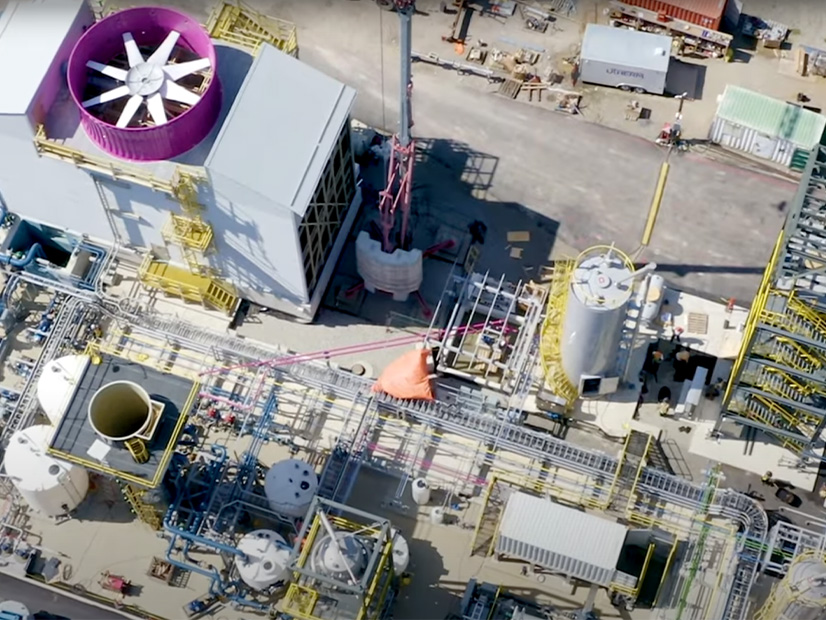
Projects in Louisiana and Texas have been chosen as the first two direct air capture (DAC) hubs to receive up to $1.2 billion in funding from the Infrastructure Investment and Jobs Act, the Department of Energy announced Friday.
The South Texas DAC hub and the Project Cypress DAC hub in Louisiana “are going to build regional direct air capture hubs, and that means they’re going to link everything from capture to processing to deep underground storage, all in one seamless process,” Energy Secretary Jennifer Granholm said during a Thursday press call.
Granholm described the technology as “essentially giant vacuums that can suck decades of old carbon pollution straight out of the sky, and once you harness that pollution, we can trap it permanently underground, or we can turn it into building materials … agricultural products or even clean fuels.”
Combined, the Texas and Louisiana projects are expected to take more than 2 million metric tons of carbon dioxide out of the atmosphere per year, “like taking nearly half a billion gas-powered cars off the road,” she said. “These hubs are going to help us prove out the potential of this game-changing technology so that others can follow in their footsteps.”
Mitch Landrieu, White House senior advisor and infrastructure coordinator, said the projects are “the first direct air capture projects at this scale in the United States and will be the largest in the world.”
Occidental Petroleum and its carbon-capture subsidiary 1PointFive are developing the South Texas DAC hub on 106,000 acres at King Ranch, an agribusiness ranch and farm that is larger than the state of Rhode Island, according to its website.
The project will use technology developed by Carbon Engineering Ltd. of British Columbia that “draws air into a facility using a series of large fans” and separates out the carbon via a chain of chemical interactions, as described on the 1PointFive website. The carbon, in liquid form, can be compressed and stored underground or processed to be used as feedstock for other products.
Battelle, a technology developer that manages seven of DOE’s national labs, is leading the Project Cypress DAC hub to be located on the Gulf Coast in southwest Louisiana. The company is partnering with two carbon capture companies — Climeworks Corp. and Heirloom Carbon Technologies — with the intention of combining their different technologies. Climeworks uses fans, filters and heat to capture carbon, while Heirloom has developed a process to absorb CO2 using limestone.
The two projects are the first of four DAC hubs to get a slice of the $3.5 billion the IIJA provided to develop the technology at commercial scale. Noah Deich, deputy assistant secretary of DOE’s Office of Carbon Management, said the two projects were chosen based on a rigorous review of their technical readiness, financial viability, and community benefits plans.
DOE has provided early funding of $3 million to $12 million to 19 DAC projects still in development, with the goal of getting ready to compete for the other two hub awards, he said.
“It will be a bit before we open up the funding,” Deich said in an interview with NetZero Insider. “It’s intentional so that we can let this direct air capture field catch up, and we don’t want to lock in any one technology that happened to get a head start. We really wanted diversity of technology approaches, a diversity of business models [and] geographies.”
Getting to Scale
Direct air capture, like carbon capture, has raised concerns and skepticism among some environmental groups, which have pointed to its expense, high power requirements and its potential use for enhanced oil recovery. At the same time, it has garnered strong support from lawmakers from states with a long history of fossil fuel production, including Sen. Joe Manchin (D-W.Va.).
Kelly Cummins, deputy director of DOE’s Office of Clean Energy Demonstrations, said that neither of the DAC hubs will use captured carbon for enhanced oil recovery, a process in which carbon dioxide is injected into low-producing wells to increase their output.
Asked about the power source for the Louisiana project, Lewis Von Thaer, CEO of Battelle, said the company would be buying clean energy from the local power provider to start, but intended to build renewable energy for the project later.
Both Occidental and Battelle have to match the IIJA funds dollar for dollar, but they stand to benefit from the $180 per ton tax credits for DAC in the Inflation Reduction Act. Still, for first-of-a-kind projects, DOE is encouraging the hubs to develop additional revenue streams, if necessary, to ensure they are financially viable, Deich said.
He pointed to the “voluntary market” for carbon removal offtake agreements, such as 10-year agreement Climeworks signed with Microsoft in July 2022, to take 10,000 tons of CO2 out of the atmosphere on the software giant’s behalf.
“There’s greater demand than supply, and these projects will be really critical for helping to fill that gap once they do start to come online,” Deich said. Such agreements also will be vital to help the early demonstration hubs get to commercial scale, he said.
Echoing Deich, Madelyn Morrison, government affairs manager for the Carbon Capture Coalition, hailed the announcement of the two hubs as an important step “to help realize economies of scale and support the decarbonization of the American economy. As such, today’s announcement provides major headway to kickstart the deployment of large-scale DAC projects as well as to foster the development of promising earlier-stage efforts.”


